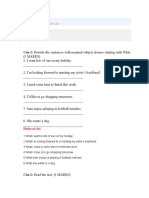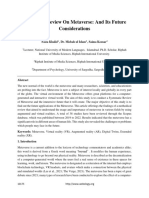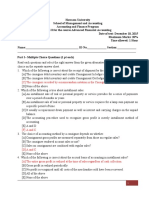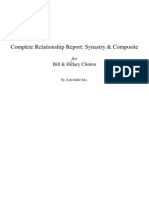Metaverso o
Metaverso o
Uploaded by
Sergio VartoloCopyright:
Available Formats
Metaverso o
Metaverso o
Uploaded by
Sergio VartoloCopyright
Available Formats
Share this document
Did you find this document useful?
Is this content inappropriate?
Copyright:
Available Formats
Metaverso o
Metaverso o
Uploaded by
Sergio VartoloCopyright:
Available Formats
Metaverse or
Metacurse?
19th February, 2022
Usman W. Chohan, MBA, PhD
Discussion Paper Series: Notes on the 21st Century
Abstract: The notion of a “metaverse” alludes to a network of 3D virtual realities, with an
emphasis on social engagement mediated through virtual space and augmented reality.
Powerful interests are advocating for the development of metaverse(s), but the relegation of
the human to a collective dematerialized ether has been met with severe criticisms. The aim
of this paper, then, is to examine the question of metaverse across a wider canvas.
Electronic copy available at: https://ssrn.com/abstract=4038770
1
Metaverse or Metacurse?
The notion of a “metaverse” alludes to a network of three-dimensional virtual realities, with
an emphasis on social engagement mediated through virtual space and augmented reality
(Dionisio et al., 2013). As a portmanteau of “meta” and “universe,” it speaks to a totalizing
immersive experience in which agents can engage with one another through some form of
technologically-facilitated virtual arrangement beyond the real, material dimension
(Ondrejka, 2004), which Jaynes et al. once described as “inexpensive, self-configuring,
immersive environments” (2003) It also suggests a single, universal simulacrum rather than
a set of discrete compartments, and ascribes considerable weight to the creation of virtual
economies1 (see Bourlakis, M., Papagiannidis, 2009; Chohan, 2022a). The supposed
economic benefits from meta use might include work productivity improvements,
e-learning interactivity (education; see Duan et al., 2021), e-commerce applications, and
virtual real estate development as alternative asset class (van der Werve, 2021).
The original use of the term derives from Stephenson's Snow Crash (1992), which depicted a
virtual planetary simulacrum in which humans interact with one another and with bots
through avatars on The Street, a finite linear space with real estate owned by a single
corporate entity.2 The best-selling series of The Matrix has also left a significant (perhaps
indelible) mark on the popular imagination in terms of the challenge of distinguishing
between Baudrillad’s Simulation and Simulacra (1994), pinning anarchist-survivalists against
machines that have turned humans into batteries and captured their minds in a perpetual
simulation. The term has gained much greater popularity due to newer works such as Ready
1
Stephenson’s original depiction of the metaverse itself alludes to anarcho-capitalism or
cryptoanarchism as economic system (1992; Chohan, 2017)
2
Snow Crash uses the parable of immersive three dimensional virtual space as a successor to the
internet, wherein users can purchase and exchange real estate from the Global Multimedia Protocol
Group, and join into the metaverse after hooking themselves to personal terminals or booths with
goggles.
Electronic copy available at: https://ssrn.com/abstract=4038770
2
Player One, and Facebook's transformation as of late 2021 into the Meta platform. However,
prototypes of metaverses may be seen in earlier efforts, particularly in the videogame
domain, beginning with Second Life (see Kemp and Livingstone, 2006) and continuing to
other MMORPGs over the past two decades.34
Virtual reality headsets have existed but suffer from technological limitations in mass
market delivery: higher-end devices require clunky wiring and heavy hardware, while
cheaper headsets do not deliver a stimulating enough virtual experience. There is, as such, a
sustained trade-off between cost and quality - between high graphics and mobility; and
prices of headsets are still in an expensive range (Angelov et al., 2020; Castelvecchi, 2016).
This also raises questions about economic access and inequality, what is sometimes
referred to as the “digital divide” (van Dijk and Hacker, 2003; Chohan, 2022a). Aside from
the hardware, there are problems of software interoperability among the many projects. At
the current stage, there is no wide-scale adoption of standardized technical specifications
for metaverse(s), given that each project relies on proprietary technology. The unwillingness
to share proprietary technologies, based on privacy and transparency considerations, is a
hindrance to wider development, and it is likely that something larger than corporate profit
will have to drive the harmonization of standards, which is why some countries are pursuing
the challenge independently.5
At the same time, the corporate nature of its popularization has led many to allege the
notion of “meta” as being a buzzword,6 one that:
1. draws upon technologies that are unready to be deployed at the level envisaged
(such as AI and next-gen blockchain, see Jeon et al., 2022), thus exaggerating the
development stages as a public relations effort;
2. represents reverberations of existing technologies and software (Ondrejka, 2004);
3. constitutes feeble efforts to modernize what are clunky but enormous monopolies of
the present system (Chohan, 2021a);
3
MMORPG: Massive multiplayer online role playing game; a genre of videogames, and one that is
highly popular and lucrative, although development of MMORPGs entail significant costs.
4
Other games which are described as prototypes include Minecraft, Roblox, Active Worlds, No Man’s
Sky, Fallout 76, The Palace, Decentraland, and Fortnite.
5
For example, South Korea is taking a leading initiative in harmonizing metaverse standards
6
This parody video depicting Zuckerberg as a frightening villain sets an interesting tone for public
wariness about Facebook’s Meta plans.
Electronic copy available at: https://ssrn.com/abstract=4038770
3
4. serves as a new marketing ploy to downplay the amount of social, political and
psychological damage caused by social media usage, including social media
addiction, user safety and information privacy issues78 (see review in Chohan and
DeSouza, 2020).
The corporate boom followed Facebook renaming its overall platform to “Meta Platforms,”9
and vowed to spend a warchest to build up the metaverse, and advertised heavily to
persuade the public of its new ambitions.10 But Facebook is by no means the only entity
interested in such technologies.11 These were not received well by the investor community
or by the public, and Meta’s stock price has plunged since promotion efforts for the
metaverse seriously began.12 Not only do many of the technologies purported by Meta
Platforms still need to be developed, but criticism has come from numerous corners
regarding the culture that is emerging on the metaverse they desire, as for example in cases
of sexual harrassment in the meta (Basu, T, 2021; see also Garon, 2022). The nature of
racism, sexism, hate speech, propaganda, echo chambers, psychological violence,
demoralization, and other issues risks being magnified in the virtual realm (see also Franks,
2011; Shriram and Schwartz, 2017).
Given the ambition involved, not to mention the technical effort and money being thrown at
the project, the stakes are very high, and so are the risks to society - a point that has been
emphasized as “unknowable societal risks” (Oxford Analytica, 2021). The question of virtual
crimes, which is now a rich legal literature of three decades (Brenner, 2001, 2008; Howell,
2004), requires urgent reconsideration in light of greater user adoption, advancing
technologies, and strong corporate motives to implement projects of such scale. Without
this, given the aforementioned considerations, the notion of a metaverse may well turn into
7
For example, Meta has announced that it will use targeted advertising strategies in the metaverse,
which means that it will be actively gathering substantial amounts of information about the users,
thus raising renewed concerns about facebook’s privacy strategy.
8
The outstanding work by Franks (2011) on “unwilling avatars” speaks vividly to the conundrum faced
in the (de)socialization that the metaverse risks unraveling
9
Several years ago, Google had similarly changed its parent name to Alphabet
10
The question remains about the sorts of currencies that would be used in a metaverse, for example,
in whether NFTs or DeFi would be connected through to metaverse systems.
11
For example, Microsoft acquired the VR company AltspaceVR in 2017, and has already
implemented features of the metaverse such as virtual avatars and meetings held in virtual reality
into Microsoft Teams.
12
Between September 2021 and February 2022, the stock of Meta crashed by -45%, and
Zuckerberg’s holdings lost
Electronic copy available at: https://ssrn.com/abstract=4038770
4
a metacurse. Unlike the previous disruptive iterations of internet-age projects, the
metaverse has been proactively grappled with by various types of scholars and writers. The
cautionary tales set by The Matrix, Ready Player One, and Snow Crash already paint a
dystopian picture in the popular imagination. The equity markets are also punishing
Facebook (meta) for several reasons including the overinvestment and poor reception of the
meta project (in addition to declining user base). The condition of virtual crimes being
magnified, of trade-offs in technology, of user privacy, and of anti-social elements
dominating the space; all augur poorly for metaverse/metacurse eventuality.
Electronic copy available at: https://ssrn.com/abstract=4038770
5
References
1. Angelov, V., Petkov, E., Shipkovenski, G., & Kalushkov, T. (2020, June). Modern virtual reality
headsets. In 2020 International Congress on Human-Computer Interaction, Optimization and
Robotic Applications (HORA) (pp. 1-5). IEEE.
2. Basu, T. (2021). The metaverse has a groping problem already. MIT Technology Review.
December 16.
3. Baudrillard, J. (1994). Simulacra and simulation. University of Michigan press.
4. Bourlakis, M., Papagiannidis, S., & Li, F. (2009). Retail spatial evolution: paving the way from
traditional to metaverse retailing. Electronic Commerce Research, 9(1), 135-148.Chohan, U. W.
(2017). Cryptoanarchism and cryptocurrencies. Available at SSRN 3079241.
5. Brenner, S. W. (2001). Is there such a thing as' Virtual Crime'?. California Criminal Law Review,
4(1).
6. Brenner, S. W. (2008). Fantasy crime: The role of criminal law in virtual worlds. Vand. J. Ent. &
Tech. L., 11, 1.
7. Castelvecchi, D. (2016). Low-cost headsets boost virtual reality's lab appeal. Nature,
533(7602).
8. Chohan, U. W. (2021a). Public Value and the Digital Economy. Routledge.
9. Chohan, U. W. (2021b). Non-fungible tokens: Blockchains, scarcity, and value. Critical
Blockchain Research Initiative (CBRI) Working Papers.
10. Chohan, U. W. (2021c). Decentralized finance (DeFi): an emergent alternative financial
architecture. Critical Blockchain Research Initiative (CBRI) Working Papers.
11. Chohan, U. W. (2022a). Cryptocurrencies: A brief thematic review. Available at SSRN
3024330.
12. Chohan, U. W. (2022b). Cryptocurrencies and inequality. In Cryptofinance: A New Currency for
a New Economy (pp. 49-62).
13. Chohan, U. W., & D'Souza, A. (2020). The Joys & Ills of Social Media: A Review. Available at
SSRN 3517813.ionisio, J. D. N., III, W. G. B., & Gilbert, R. (2013). 3D virtual worlds and the
metaverse: Current status and future possibilities. ACM Computing Surveys (CSUR), 45(3),
1-38.
14. Duan, H., Li, J., Fan, S., Lin, Z., Wu, X., & Cai, W. (2021, October). Metaverse for social good: A
university campus prototype. In Proceedings of the 29th ACM International Conference on
Multimedia (pp. 153-161).
15. Franks, M. A. (2011). Unwilling avatars: Idealism and discrimination in cyberspace. Colum. J.
Gender & L., 20, 224.
16. Howell, B. A. (2004). Real world problems of virtual crime. Yale JL & Tech., 7, 103.
17. Jaynes, C., Seales, W. B., Calvert, K., Fei, Z., & Griffioen, J. (2003, May). The Metaverse: a
networked collection of inexpensive, self-configuring, immersive environments. In
Proceedings of the workshop on Virtual environments 2003 (pp. 115-124).
Electronic copy available at: https://ssrn.com/abstract=4038770
6
18. Jeon, H. J., Youn, H. C., Ko, S. M., & Kim, T. H. (2022). Blockchain and AI Meet in the Metaverse.
Advances in the Convergence of Blockchain and Artificial Intelligence, 73.
19. Kemp, J., & Livingstone, D. (2006, August). Putting a Second Life “metaverse” skin on learning
management systems. In Proceedings of the Second Life education workshop at the Second
Life community convention (Vol. 20). CA, San Francisco: The University of Paisley.
20. Ondrejka, C. (2004). Escaping the gilded cage: User created content and building the
metaverse. NYL Sch. L. Rev., 49, 81.
21. Oxford Analytica. (2022). Metaverse holds unknowable societal risks. Emerald Expert
Briefings, (oxan-db).
22. Shriram, K., & Schwartz, R. (2017, March). All are welcome: Using VR ethnography to explore
harassment behavior in immersive social virtual reality. In 2017 IEEE Virtual Reality (VR) (pp.
225-226). IEEE.
23. Stephenson, N. (1992). Snow Crash. Bantam Books.
24. van der Merwe, D. (2021). The Metaverse as Virtual Heterotopia. In 3rd world conference on
research in social sciences.
25. Van Dijk, J., & Hacker, K. (2003). The digital divide as a complex and dynamic phenomenon.
The information society, 19(4), 315-326.
Electronic copy available at: https://ssrn.com/abstract=4038770
7
Also in this series available on SSRN
Electronic copy available at: https://ssrn.com/abstract=4038770
You might also like
- Bai 3. Metaverse Literature Review Synthesis and Future Research AgendaDocument22 pagesBai 3. Metaverse Literature Review Synthesis and Future Research Agendadarkwjng1997No ratings yet
- 6 - Lecture - The 8 Es in AuditingDocument11 pages6 - Lecture - The 8 Es in AuditingKris MendezNo ratings yet
- PlotDocument2 pagesPlotAlex GregorieNo ratings yet
- BÀI KT 2 K NĂNG T NG H P 4 B2-PhúcDocument4 pagesBÀI KT 2 K NĂNG T NG H P 4 B2-PhúcMy Tien Tran67% (3)
- Metaverse Through The Prism of Power and AddictionDocument24 pagesMetaverse Through The Prism of Power and AddictionSummerGirlNo ratings yet
- 20230123040834pmWEBOLOGY 19 (2) - 729Document15 pages20230123040834pmWEBOLOGY 19 (2) - 729RavirajNo ratings yet
- 00-Advertising in the Metaverse_ Research AgendaDocument5 pages00-Advertising in the Metaverse_ Research AgendaSonalikaNo ratings yet
- Advertising in The Metaverse Research AgendaDocument5 pagesAdvertising in The Metaverse Research Agendacaizichen888No ratings yet
- Roquet - Japan's Retreat To The MetaverseDocument19 pagesRoquet - Japan's Retreat To The MetaversemonurguzelNo ratings yet
- 1 s2.0 S0148296322008852 MainDocument19 pages1 s2.0 S0148296322008852 MainSkru yaayNo ratings yet
- 1 s2.0 S0148296322008852 MainDocument19 pages1 s2.0 S0148296322008852 MainAbhilasha SinghNo ratings yet
- SSRN Id4325266Document3 pagesSSRN Id4325266Chethan SNo ratings yet
- J Consum Psychol - 2023 - Hadi - The Metaverse A New Digital Frontier For Consumer BehaviorDocument25 pagesJ Consum Psychol - 2023 - Hadi - The Metaverse A New Digital Frontier For Consumer Behaviordaniela.flfe18No ratings yet
- 2023 P2 11842 Gye Cajamarca - IsaacDocument7 pages2023 P2 11842 Gye Cajamarca - IsaacJHONATAN BOLIVAR QUISHPE CASANo ratings yet
- Metaverse Year OneDocument6 pagesMetaverse Year Oneakunbisnis4576No ratings yet
- J Consum Psychol - 2023 - HadiDocument25 pagesJ Consum Psychol - 2023 - HadiValentina Sharon DharmawanNo ratings yet
- Fusing Blockchain and AI With Metaverse A SurveyDocument15 pagesFusing Blockchain and AI With Metaverse A Surveywer78230No ratings yet
- Sustainability 15 14940Document17 pagesSustainability 15 14940ngocphu3017No ratings yet
- Criminal Liability of The MetaverseDocument9 pagesCriminal Liability of The Metaverseelansary108No ratings yet
- MetaverseDocument26 pagesMetaversenphotographer99No ratings yet
- 2022 - Analysis of The Future Prospects For The MetaverseDocument6 pages2022 - Analysis of The Future Prospects For The MetaverseElanthamil PandiNo ratings yet
- s43762-022-00051-0Document22 pagess43762-022-00051-0PRISCILA JUNQUEIRA DE SOUZANo ratings yet
- A Metaverse: Taxonomy, Components, Applications, and Open ChallengesDocument43 pagesA Metaverse: Taxonomy, Components, Applications, and Open ChallengesgichegNo ratings yet
- Remodeling Digital MarketplaceDocument30 pagesRemodeling Digital MarketplaceHaardika SethiNo ratings yet
- Virtualworlds 02 00019Document18 pagesVirtualworlds 02 00019kuasaraya40No ratings yet
- NG 38-4Document16 pagesNG 38-41825paperwishesNo ratings yet
- MetaverseDocument22 pagesMetaverseyujiao liNo ratings yet
- 10.18038 Estubtda.1170931 2632228 2Document12 pages10.18038 Estubtda.1170931 2632228 2Cecilia HernándezNo ratings yet
- JONES WorkingsocialVR 2022Document24 pagesJONES WorkingsocialVR 2022alexcanahualpaNo ratings yet
- Edae 032Document12 pagesEdae 032Aziz Ur RehmanNo ratings yet
- A Metaverse: Taxonomy, Components, Applications, and Open ChallengesDocument44 pagesA Metaverse: Taxonomy, Components, Applications, and Open ChallengesAshar AliNo ratings yet
- The Metaverse FilesDocument15 pagesThe Metaverse FilesBrennanNo ratings yet
- Security and Privacy in Metaverse-5Document16 pagesSecurity and Privacy in Metaverse-5AnissaNo ratings yet
- A Survey On Decentralized Metaverse Using Blockchain and Web 3.0 Technologies Applications and MoreDocument34 pagesA Survey On Decentralized Metaverse Using Blockchain and Web 3.0 Technologies Applications and Moredk20030205No ratings yet
- 1 s2.0 S0278612522001959 MainDocument7 pages1 s2.0 S0278612522001959 Mainariana.hamzehpourNo ratings yet
- MetaverseDocument17 pagesMetaversesushmaNo ratings yet
- Anga MetaverseDocument20 pagesAnga Metaverse20j41a05f0No ratings yet
- Metaverse Case StudyDocument17 pagesMetaverse Case StudyJayesh PaliwalNo ratings yet
- 3D Virtual Worlds and The Metaverse Current Status and Future PossibilitiesDocument45 pages3D Virtual Worlds and The Metaverse Current Status and Future PossibilitiesWill BurnsNo ratings yet
- 1-s2.0-S0016328723001623-mainDocument23 pages1-s2.0-S0016328723001623-mainwyffffffffNo ratings yet
- 1 s2.0 S0747563222004629 MainDocument10 pages1 s2.0 S0747563222004629 MainHunna ShoaibNo ratings yet
- Dhruv SeminarDocument38 pagesDhruv Seminar159Trupt VaghaniNo ratings yet
- Utopia BlockchainDocument12 pagesUtopia BlockchainGréta KovácsNo ratings yet
- Fin Irjmets1668971811Document3 pagesFin Irjmets1668971811Rakshitha GajendraNo ratings yet
- Mathematics 11 00941 v2Document41 pagesMathematics 11 00941 v2onkar mohiteNo ratings yet
- Sustainability 16 00934Document24 pagesSustainability 16 00934canizalesNo ratings yet
- Visualization and Cybersecurity in The Metaverse A SurveyDocument15 pagesVisualization and Cybersecurity in The Metaverse A SurveySummerGirlNo ratings yet
- Mystakidis2022 MetaverseDocument13 pagesMystakidis2022 MetaverseVennela NandikondaNo ratings yet
- Keamanan, Data Pribadi Pada MetaverseDocument10 pagesKeamanan, Data Pribadi Pada Metaversesurohman.itkNo ratings yet
- Humbatov GafarliDocument4 pagesHumbatov GafarliAysu GafarliNo ratings yet
- Metaverse Ed1Document67 pagesMetaverse Ed1Clancy Li100% (1)
- Gupta OA 1Document15 pagesGupta OA 1Ayu Rezky Amelia CullenNo ratings yet
- 41762-95827-1-PB Published JMBIDocument11 pages41762-95827-1-PB Published JMBIAdrie OktavioNo ratings yet
- Lectura CiberdefensaDocument14 pagesLectura Ciberdefensadarwinner11No ratings yet
- Augmented Reality, Augmented Epistemology, and The Real World WebDocument28 pagesAugmented Reality, Augmented Epistemology, and The Real World WebXe hingNo ratings yet
- Introduction Pilot StudyDocument1 pageIntroduction Pilot StudytardesjovenesNo ratings yet
- Ijrpr2593 Metaverse Future of The InternetDocument5 pagesIjrpr2593 Metaverse Future of The InternetgeethanjalipamalaNo ratings yet
- MetaverseDocument13 pagesMetaversekvfsdbvkNo ratings yet
- Exploring The Next Frontier of Digital InteractionDocument2 pagesExploring The Next Frontier of Digital InteractionAmbrish UpadhyayNo ratings yet
- Once Upon Tomorrow: Harnessing the New Opportunities the Metaverse CreatesFrom EverandOnce Upon Tomorrow: Harnessing the New Opportunities the Metaverse CreatesNo ratings yet
- Antiragging FormDocument2 pagesAntiragging FormMohitNo ratings yet
- Preliminary Investigation in Criminal CasesDocument5 pagesPreliminary Investigation in Criminal CasesSimon WolfNo ratings yet
- History The Tainos - 231002 - 084644Document10 pagesHistory The Tainos - 231002 - 084644taneshawhite933No ratings yet
- X90747 (Ma7169)Document3 pagesX90747 (Ma7169)saranNo ratings yet
- Cesc Handouts q1Document8 pagesCesc Handouts q1sandra mae dulay100% (1)
- Harvard Business Review - Manage Your EnergyDocument2 pagesHarvard Business Review - Manage Your EnergyrenatosipeNo ratings yet
- Adv. Fin. Acct Test-2Document4 pagesAdv. Fin. Acct Test-2Samuel DebebeNo ratings yet
- Railway Reservation SystemDocument17 pagesRailway Reservation SystemIrfanUllahNo ratings yet
- CARAVAL - Opening ExtractDocument29 pagesCARAVAL - Opening ExtractHodder Stoughton100% (1)
- Mungara Elizabeth PDFDocument89 pagesMungara Elizabeth PDFLenna MaeNo ratings yet
- All The Slang Words For Vagina You Need To Know - Thought CatalogDocument21 pagesAll The Slang Words For Vagina You Need To Know - Thought CatalogP. E. I. AcademicsNo ratings yet
- Oliva 2009 Test Review GuideDocument2 pagesOliva 2009 Test Review GuiderudyhilkyaNo ratings yet
- Chapter4 Anova Experimental Design AnalysisDocument31 pagesChapter4 Anova Experimental Design AnalysisAnup ŠářkarNo ratings yet
- BI Robinson ProjectDocument12 pagesBI Robinson ProjectKevin Yek Kevin100% (1)
- Election & Admin Law - San Beda 2013Document82 pagesElection & Admin Law - San Beda 2013Gonzales Juliefer AnnNo ratings yet
- From Seventh To Ten SemesterDocument55 pagesFrom Seventh To Ten SemesterTaashifNo ratings yet
- Sara ScriptDocument4 pagesSara Scriptapi-693964942No ratings yet
- EARLY Childhood EducationDocument10 pagesEARLY Childhood EducationNoor Fazilah100% (1)
- An Approach To The Operation of The Arbatel of MagicDocument4 pagesAn Approach To The Operation of The Arbatel of MagicanyasijoNo ratings yet
- SAP Transaction Codes SM19 and SM20Document8 pagesSAP Transaction Codes SM19 and SM20Mohan KrishnaNo ratings yet
- Detailed LessonPlan in English 3Document12 pagesDetailed LessonPlan in English 3Jamie anne AbreaNo ratings yet
- AA English GRE Suggested Reading ListDocument4 pagesAA English GRE Suggested Reading ListMuhammad HammadNo ratings yet
- Synastry and Composite Report For Bill and Hillary Clinton (Astrolabe Sample)Document66 pagesSynastry and Composite Report For Bill and Hillary Clinton (Astrolabe Sample)Jeffrey KishnerNo ratings yet
- Tagasalo Personality ArraDocument48 pagesTagasalo Personality Arraava12345678900% (1)
- Jamie Black Mountain College 1Document7 pagesJamie Black Mountain College 1api-707926496No ratings yet
- Study of Perception of College Going Young Adults Towards Online Streaming ServicesDocument5 pagesStudy of Perception of College Going Young Adults Towards Online Streaming ServicesPrajwal KadamNo ratings yet
- Jurnal 2Document6 pagesJurnal 2IrdaniatiNo ratings yet

























































































